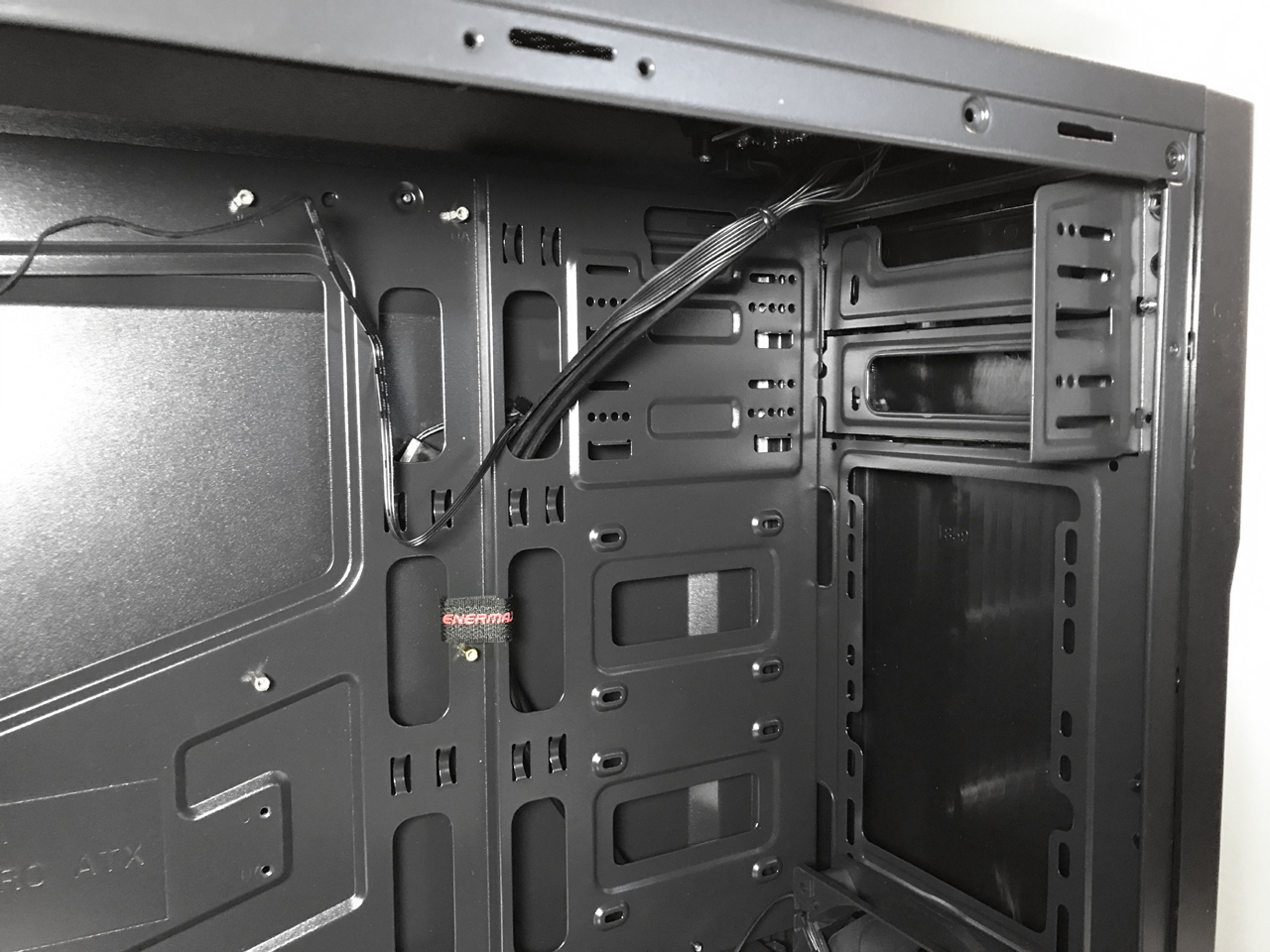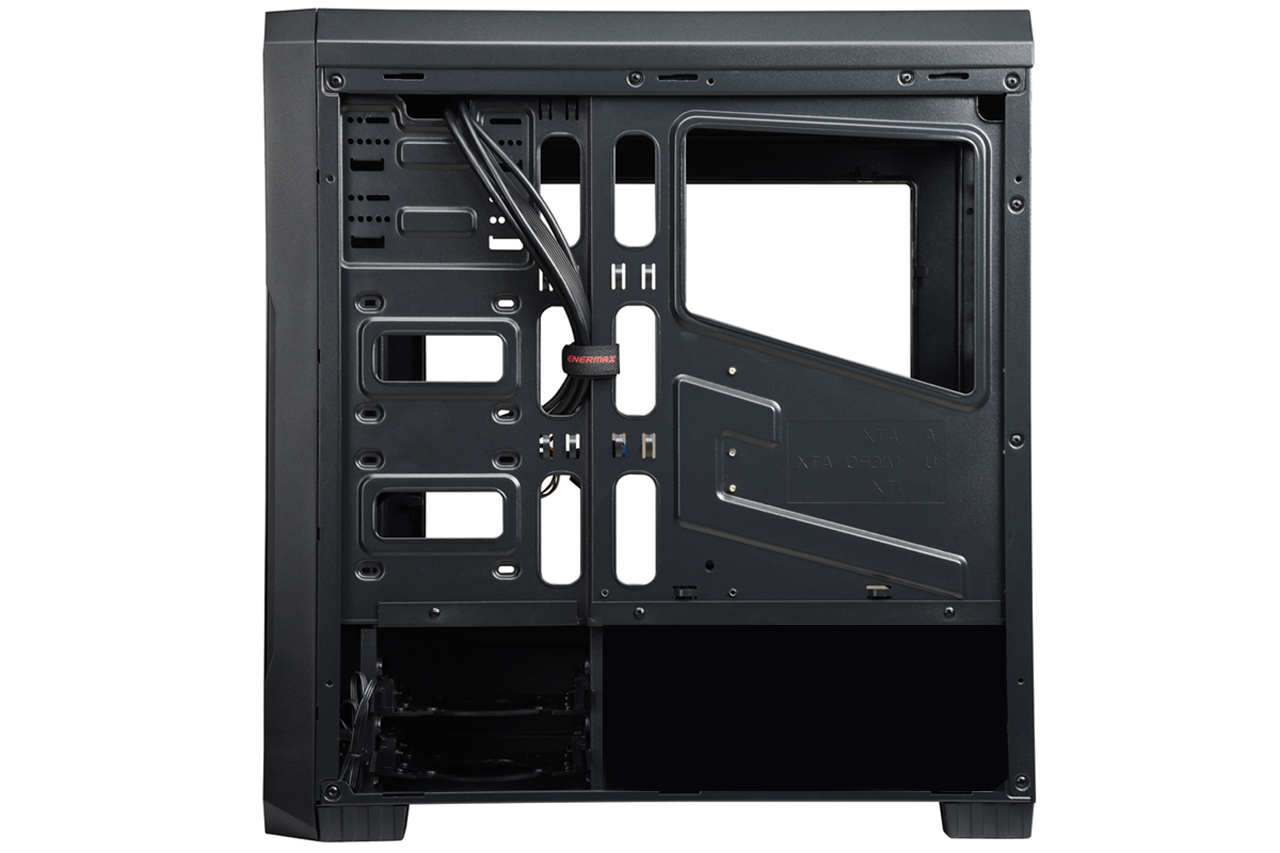Enermax Ostrog Lite Case Review
Why you can trust Tom's Hardware
Component Installation
Accessories come in a plastic bag zip-tied to the motherboard tray. You will find various screws, zip ties, and an owners manual.
The interior of the chassis is large enough to support up to ATX motherboards. The seven expansion slots will accommodate 3-way SLI and CrossFire, but we don't see many people buying an entry-level mid-tower case like this to house a triple GPU set-up. Nevertheless, there is more than enough room for most dual GPU configurations and long graphics cards up to 16.7".
There are six cable pass-through holes with rolled metal edges in the motherboard tray for cable management. But depending on the size of the motherboard you install, you may not have access to more than three of the six cable management holes. There is also a large hole in the motherboard mounting plate behind the CPU socket area that allows for heatsink changes without having to remove the motherboard. The uppermost cable pass-through hole at the upper edge of the motherboard tray is specifically designed to route fan cables and a 12V motherboard power cable. we highly recommend routing the EPS12V power cable behind the motherboard tray before installing your motherboard, because it is impossible to do so afterward.
The cable management area directly behind the motherboard tray is almost non-existent, while the area to the side of the motherboard tray is limited to roughly a quarter of an inch.


At the bottom of the main compartment you will find a large non-removable PSU tunnel that covers your power supply and two drive bays. Because of the size and position of the side panel window, the PSU cover is a bit redundant; you can't actually see the PSU with the side panel in place. Additionally, there is an 82/92mm fan mounting location on the top of the PSU tunnel near the front of the chassis.



The Ostrog Lite is equipped with two space saving 5.25" optical drive bay slots in the main component compartment. As you can see from the photos, the cut-away design of the 5.25" drive bays allows optical drives to be supported in the front, while holes in the motherboard tray let you attach the rear of your optical drives to the chassis frame. This case is equipped with a removable plastic 5.25" drive bay adapter so you can mount a 3.5" drive or 80mm fan in the optical drive bay area. Two of the four hard drive mounting locations are placed behind the motherboard tray and support both 2.5" and 3.5" drives via plastic hard drive caddies. The case also features a pair of dedicated mounting locations for 2.5" SSDs on the motherboard tray in the main component compartment.
The Enermax Ostrog Lite is outfitted with a single 120mm intake fan in the front of the chassis and a 120mm Enermax Apollish LED fan in the rear of the case near the CPU socket area. In total, you can install up to five 120mm, one 80mm, and one 82/92mm fans. The mounting locations on the top and front of the case can accommodate up to two 120mm fans. The rear exhaust fan location supports one 120mm fan.
Get Tom's Hardware's best news and in-depth reviews, straight to your inbox.
Although things were tight, we were able to install several different power supplies up to 220mm in length without issue. Any time there's limited space behind the motherboard tray, we highly recommend using a modular power supply. The Enermax Ostrog Lite can be equipped with coolers up to 152mm tall and can accommodate graphics cards up to 390mm in length.
Cooling
Even though the Enermax website lists only one location for mounting radiators in this chassis, we found that radiators and all-in-one coolers can actually be mounted in three separate locations. The mounting locations in the top of the chassis support 120mm and 240mm radiators, as do the mounting locations in the front of the chassis. Finally, a 120mm all-in-one cooler can be mounted in the exhaust fan location.
The 120mm intake fan in the front of the case feeding the 120mm exhaust fan in the top of the chassis didn't seem to provide adequate airflow. This is likely due to the air intake slot at the bottom of the front fascia restricting airflow. Also, the airflow into the chassis is divided by the PSU tunnel. Although this type of design provides airflow to the hard drive racks, it diverts airflow away from the hotter components that need it most.
The two 120mm mounting locations in the top of the case can be used with a wide range of 120mm radiators and all-in-one coolers from various manufacturers. As is the case with most chassis that have mounting locations in the top panel, some coolers may be limited to a single fan configuration, depending on the size of your motherboard.
Those of you with plans to internally mount a 240mm all-in-one cooler can do so in mounting locations in the top and front of the chassis. Even though most all-in-one coolers can be physically mounted in the front of this chassis, due to the fixed length of the tubing, some coolers are unable to reach the CPU socket. However, these locations are ideal for mounting radiators for water-cooled graphics cards. The rear exhaust fan location behind the CPU socket area supports 120mm radiators and all-in-one coolers in single and dual fan configurations.
MORE: Best Cases
MORE: All Case Content
Current page: Component Installation
Prev Page Features & Specifications Next Page Benchmarks & ConclusionSteven Lynch is a contributor for Tom’s Hardware, primarily covering case reviews and news.
-
AgentLozen ReplySteven Lynch said:...we believe most people will find the minimalist design of the Enermax Ostrog Lite handsome
I'm all about simple and elegant cases. I HATE LED lights unless they're used in a minimalist way. I want my computer to say, "I was built by an adult with adult sensibilities." It's just a shame that the insides are so small. -
mickrc3 I bought two of these cases on sale for $24.99 each for builds for family members. One built so far. Very easy to work in and look good on a desk. The mount position for the fan on the PSU tunnel is awkward. The 92mm fan I put there was way too noisy for the amount of airflow it provides. I disconnected it but may add a speed control to slow it down to reduce noise. Plenty of room for the GTX970 video card.Reply



